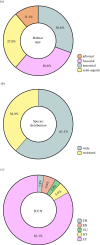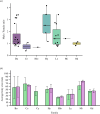Research on longevity and associated age data of South American anurans: trends, gaps and recommendations
- PMID: 39619792
- PMCID: PMC11606501
- DOI: 10.1098/rsos.240973
Research on longevity and associated age data of South American anurans: trends, gaps and recommendations
Abstract
Longevity is one of the most important characteristics in the life history of organisms. It is directly associated with growth, reproduction and age of sexual maturity. Despite this, little is known about longevity in South American anuran species, a region considered as a hotspot of world diversity. Thus, we carried out a literature review of publications on longevity of South American anurans that used the skeletochronology method to identify the main publication trends, as well as to point out the main information gaps and suggest future directions. We found clear biases when we analysed temporal, spatial and taxonomic patterns in publications on longevity: (i) studies are recent (mostly from 2015 onwards), (ii) bufonids and leptodactylids were the most studied groups, (iii) medium to large species are the most studied, (iv) species with wide geographic distribution, low risk of extinction, (v) the studies are concentrated in Brazil and Argentina, and (vi) most studies are in the Chaco biogeographical sub-region. We suggest that future work prioritizes little explored families and with high species diversity, small-bodied species, with restricted distribution, threatened with extinction, in order to expand the representation of different evolutionary lineages along the biogeographical units of South America.
Keywords: amphibia; demography; review; skeletochronology.
© 2024 The Authors.
Conflict of interest statement
We declare we have no competing interests.
Figures






Similar articles
-
Hydroids (Cnidaria, Hydrozoa) from Mauritanian Coral Mounds.Zootaxa. 2020 Nov 16;4878(3):zootaxa.4878.3.2. doi: 10.11646/zootaxa.4878.3.2. Zootaxa. 2020. PMID: 33311142
-
Effects of Climate and Latitude on Age at Maturity and Longevity of Lizards Studied by Skeletochronology.Integr Comp Biol. 2018 Dec 1;58(6):1086-1097. doi: 10.1093/icb/icy119. Integr Comp Biol. 2018. PMID: 30307522
-
Global gaps in age data based on skeletochronology for amphibians.Integr Zool. 2022 Sep;17(5):752-763. doi: 10.1111/1749-4877.12584. Epub 2021 Sep 22. Integr Zool. 2022. PMID: 34498379 Review.
-
The 2023 Latin America report of the Lancet Countdown on health and climate change: the imperative for health-centred climate-resilient development.Lancet Reg Health Am. 2024 Apr 23;33:100746. doi: 10.1016/j.lana.2024.100746. eCollection 2024 May. Lancet Reg Health Am. 2024. PMID: 38800647 Free PMC article. Review.
-
Diversity of Acanthocephala parasites in Neotropical amphibians.J Helminthol. 2024 Jan 24;98:e11. doi: 10.1017/S0022149X23000986. J Helminthol. 2024. PMID: 38263742 Review.
References
-
- Qin F, Liu G, Huang G, Dong T, Liao Y, Xu X. 2018. Zinc application alleviates the adverse effects of lead stress more in female Morus alba than in males. Environ. Exp. Bot. 146, 68–76. (10.1016/j.envexpbot.2017.10.003) - DOI
Publication types
Associated data
LinkOut - more resources
Full Text Sources

